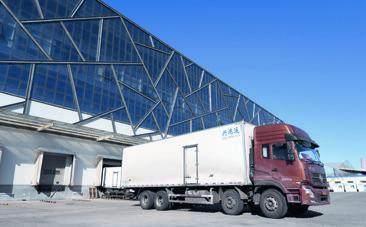IMPETUS FOR CIRCULATION
2022-05-01ByLiXiaoyang
By Li Xiaoyang


Despite the impacts of COVID-19, Chinas economy registered a steady start in the first quarter of 2022, according to the National Bureau of Statistics (NBS) on April 18. GDP grew 4.8 percent year on year to 27.02 trillion yuan ($4.24 trillion), the NBS data showed. The increase was 4 percent in the fourth quarter of 2021.
Following a strong rebound in 2021, China faced unexpected chal- lenges at the beginning of this year, with a volatile global situation and multiple, sporadic COVID-19 outbreaks at home, NBS spokesperson Fu Linghui told a press conference.
Despite heavier downward economic pressure, he said the countrys long-term economic fundamentals remain sound.
Hard-won growth
In the first three months of the year, value-added industrial output saw a 6.5-percent increase from a year prior, with that of the hi-tech manufacturing sector up 14.2 percent, much higher than the industrial average, according to the NBS. The production of new-energy vehicles, solar panels and industrial robots went up 140.8 percent, 24.3 percent and 10.2 percent, respectively.
Fixed assets investment jumped 9.3 percent. Retail sales of consumer goods went up 3.3 percent to around 10 trillion yuan ($1.57 trillion). The job market continued to expand. The surveyed urban unemployment rate stood at 5.5 percent, with 2.85 million new urban jobs created in this period.
Foreign trade also remained robust. Total imports and exports expanded 10.7 percent year on year to 9.42 trillion yuan ($1.48 trillion) in the first quarter, data from the General Administration of Customs of China (GACC) showed on April 13.
Li Kuiwen, a GACC spokesperson, told a press conference that the growth can be attributed to domestic economic recovery and increasing global demand for madein-China products. However, he cautioned that greater efforts should be made to cope with domestic and external uncertainties.
The Russia-Ukraine conflict has impacted global supply chains and led to rising commodity costs, and major developed economies are moving to withdraw quantitative easing policies, which has caused shocks in the global financial market, Wen Bin, chief analyst at China Minsheng Bank, told Beijing Review.
According to Wen, the pandemic and rising commodity prices have pushed up costs of Chinese enterprises. Meanwhile, domestic consumption of major items such as clothing, home appliances and vehicles was also affected. The recovery of the food and beverage and tourism industries remained weak. The tertiary industry grew by just 4 percent in the January-March period, showing impacts of the pandemic on services industries.
“The urgency lies in striking a balance between controlling the spread of COVID-19 at home and stabilizing domestic demand to ensure steady GDP growth in the second quarter,” he said.
Toward a better market
At the core of Chinas economic strategy during the pandemic and beyond is the dual circulation development paradigm, which allows the domestic and overseas economies to reinforce each other, with the domestic economy as the mainstay. Its implementation has gained new momentum with the publication of a guideline on developing a unified domestic market in early April.
A unified market will provide a level playing field for all market entities and improve the efficiency of distribution of resources, Xu Hongcai, Deputy Director of the Economic Policy Commission under the China Association of Policy Science, told Beijing Review.
According to the guideline, released by the Communist Party of China Central Committee and the State Council, the unified market will be highly efficient, rules-based, fair for competition and open. It will align and coordinate resources, including land, labor, capital, technology, data, energy and the environment. Over the course of its formation, its priorities will include promoting efficient circulation and expansion of the domestic market, improving the business environment, and reducing market transaction costs.
Efforts will be made to boost sci-tech innovation and upgrade industry, improve the property rights protection system, implement a unified market access system, and enhance the unified social credit system. Both new and traditional industries including new energy, infrastructure, big data, logistics and energy storage will receive boosts in the process.

The guideline emphasizes the importance of promoting the building of a modernized circulation network, improving channels for market information sharing, upgrading transaction platforms, strengthening anti-monopoly measures and cracking down on unfair competition through inappropriate conduct.
“Trade in China has always had degrees of regional separation. High logistical and administrative costs have often put negative pressure on interregional trade,” Yu Miaojie, a professor at the National School of Development at Peking University, told Beijing Review.
A unified market is based on consistent rules, shared market facilities, unimpeded sharing of goods and services, and unbiased supervision, according to Wei Jianguo, former Vice Minister of Commerce.
Although China has a large market, its resource allocation and capital flow still require improvement. In some regions, unfounded restrictions still apply to foreign and private enterprises, Wei told The Beijing News.
The efforts of some local governments to en- force tougher market access rules for private enterprises from other regions actually damage the interests of consumers and weaken the competitiveness of local firms, Su Jian, Director of the China Center for Economic Research at Peking University, was quoted as saying in an article published by China Economic Weekly in April.
The guideline underlines the importance of improving marketoriented allocation of public resources, boosting regional market integration and eliminating market barriers. The key is to boost allocation and free flow of resources including labor, land, capital and technology, encourage technological innovation, and further pool global resources through embracing foreign businesses and investment.
Major targets
“Building a unified market does not mean equalitarianism and one-sizefits-all practices. The authorities need to drive regional integration while boosting nationwide resource allocation and flow,” Xu said.
Market-oriented mechanisms are expected to be promoted across all major sectors. China has launched pilot programs in public sectors such as energy to break up monopolies by state-owned enterprises (SOEs).
To peak its carbon emissions before 2030 and achieve carbon neutrality before 2060, China has introduced a carbon credit trading platform as part of efforts to promote related technological progress and gradually squeeze heavy-polluters out of the market. Last year, the country also established marketoriented pricing mechanisms for coal-fired power.
The guideline also highlights the need to address regional barriers in key sectors such as logistics. Logistics services have had an increasing bearing on peoples wellbeing, notably for regions under COVID-19 containment measures. The logistical costs in China remain high due partly to surcharges and even unwarranted fines at checkpoints, which have not been addressed despite repeated crackdowns over the past few years.
The guideline also aims to further unleash the vitality of market players and boost new and hi-tech sectors.
Xu emphasized that reforms of SOEs will contribute to competition in the market. As China undergoes industrial restructuring, continued reliance on expanding investment and exports—which have been conventional driving forces—is no longer sustainable. The government should encourage innovation in private enterprises, and address institutional restrictions and the lack of incentives for small and medium-sized enterprises.
Technological innovation needs to be boosted to improve Chinas research and development capacity. Mechanisms should be put in place to ensure that new production necessities, such as data, are fully utilized. More efforts are needed to develop the digital economy and protect data-related intellectual property rights, Xu said.
Chen Xiaodong, a researcher at the Institute of Financial and Economic Strategy of the Chinese Academy of Social Sciences, told China Business Journal that the digital economy is key to driving the building of a unified market, which can remove regional barriers, allow governments to launch regulation and promote supplementary development of distinctive regional industries.

The free flow of labor also receives great attention in the guideline. Currently, residents with local household registrations (hukou) are given priority in obtaining public services in some regions, while migrant people encounter difficulties in accessing housing, education and medical services, which restricts the mobility of labor, Su said. In fact, there have been growing calls for reforming the hukou system over recent decades.
While many people leave western regions to work in the more economically developed east, some are also returning to their western hometowns to start their own businesses. Local governments should provide supporting policies and improve public services to create a basic safety net for them, Xu said.
Beneficial to all
Chinas endeavor to build a unified market will drive up both domestic demand and foreign trade, according to Yu. Instead of implementing protectionism, the country remains open to globalization.
“Through building a unified domestic market, China will open up its market to more imports, especially intermediate goods, which can be combined with domestically produced parts and made into products at the higher end of the production chain. Increasing the flow of personnel will also help businesses to grow. Chinese consumers will be able to enjoy highquality products at lower prices,”Yu said.
Domestic regions need to join the economic integration of China and East Asia, while avoiding vicious internal competition, he concluded. BR
